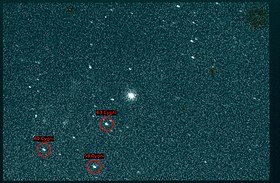V1500 Cygni or Nova Cygni 1975 was a bright nova occurring in 1975 in the constellation Cygnus. It had the second highest intrinsic brightness of any nova of the 20th century, exceeded only by CP Puppis in 1942.[10]
| Observation data Epoch J2000.0 Equinox J2000.0 | |
|---|---|
| Constellation | Cygnus |
| Right ascension | 21h 11m 36.5810s[1] |
| Declination | +48° 09′ 01.952″[1] |
| Apparent magnitude (V) | 1.69 to <21[2] |
| Characteristics | |
| Variable type | Fast nova[2] + asynchronous polar[3] |
| Astrometry | |
| Proper motion (μ) | RA: −6.449(131) mas/yr[1] Dec.: −5.572(112) mas/yr[1] |
| Parallax (π) | 0.6427 ± 0.1087 mas[1] |
| Distance | approx. 5,100 ly (approx. 1,600 pc) |
| Absolute magnitude (MV) | −10.7 (maximum)[4] to +7.8 (minimum)[5] |
| Details | |
| WD | |
| Mass | 1.20[6] M☉ |
| Radius | 0.009[7] R☉ |
| Luminosity | 5[7] L☉ |
| Temperature | 54,000[5] K |
| donor | |
| Mass | ~0.22[8] M☉ |
| Radius | 0.42[5] R☉ |
| Temperature | 3,000 - 5,200[5] K |
| Other designations | |
| Database references | |
| SIMBAD | data |

V1500 Cygni was discovered shining at an apparent brightness of magnitude 3.0 by Minoru Honda of Kurashiki, Japan on 29 August 1975.[11] It had brightened to magnitude 1.7 on the next day, and then rapidly faded. It remained visible to the naked eye for about a week, and 680 days after reaching maximum the star had dimmed by 12.5 magnitudes.

It is an AM Herculis type star, consisting of a red dwarf secondary depositing a stream of material onto a highly magnetized white dwarf primary. The distance of the V1500 Cygni was calculated in 1977 by the McDonald Observatory at 1.95 kiloparsecs (6,360 light years).[12] More recently the Gaia space observatory determined a distance of approximately 5,100 light years.[1] Additionally, V1500 Cyg was the first asynchronous polar to be discovered. This distinction refers to the fact that the white dwarf's spin period is slightly different from the binary orbital period. [13] However, by 2016, x-ray observations strongly suggested that the white dwarf rotation had returned to normal synchronization with the orbit.[4]
See also
References
Further reading
- Ferland GJ; Tomkin J; Woodman J (1976). "Continuum variability in Nova Cygni 1975". Nature. 264 (5587): 627–9. Bibcode:1976Natur.264..627F. doi:10.1038/264627a0. S2CID 4258059.
External links
- "Detail for V1500 Cygni". The International Variable Star Index. Retrieved 2008-09-09.
- "Nova Cygni 1975 (V1500 Cygni)". The Encyclopedia of Astrobiology, Astronomy and Spaceflight. Retrieved 2005-08-12.
- "V1500 Cyg (Nova Cygni 1975)". American Association of Variable Star Observers. Retrieved 2010-08-29.
